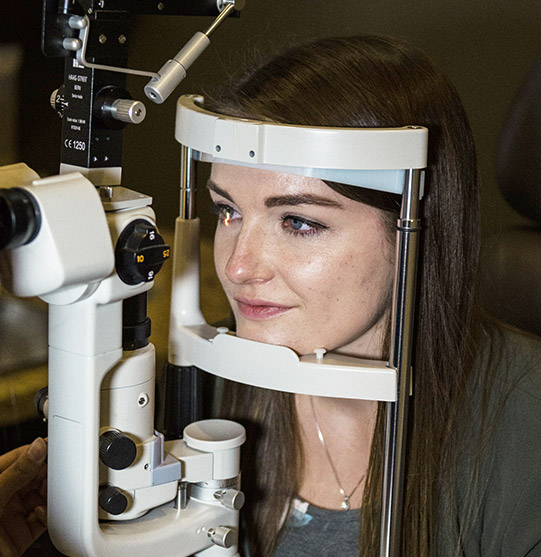
Eye Disease Diagnosis & Management in Sherwood Park
Making Your Ocular Health a Priority
Taking care of your eyes and overall health is what we do at Visionary Eye Centre. It’s important to us that you can enjoy good vision for as long as possible, and we’re here to help you do that!Did you know that most eye diseases don’t have obvious symptoms until they’ve already caused significant damage? Most patients are unaware! Severe eye conditions like glaucoma and cataracts can steal your eyesight and leave you in the dark. However, having an eye care professional monitor your ocular health can help pinpoint early signs of disease and prevent it from worsening.

Age-Related Macular Degeneration
Age-Related Macular Degeneration
Age-related macular degeneration (AMD) is a degenerative eye disease that affects the macula, the central part of the retina responsible for detailed vision. Over time, the macula begins to deteriorate, impacting how we see colour and subtle details.
Typically, AMD occurs naturally due to ageing. However, high blood pressure, obesity, smoking, and family history have been shown to contribute to the disease’s development.
There are 2 types of AMD:
Cataracts
Cataracts
Cataracts are a natural part of ageing that affects thousands of Canadians. They occur when the naturally clear lens in the eye begins to cloud over, obstructing vision. Cataracts can range from mild to very severe, completely blocking vision. Cataracts that are mild to moderate can likely be managed with eyeglasses or contact lenses, but severe cataracts often need surgery to remove and replace them.
Glaucoma
Glaucoma
Glaucoma is often referred to as “the silent thief of sight” due to its asymptomatic nature and tendency to steal your vision completely. It’s a degenerative disease that affects the optic nerve and can lead to irreversible damage and even blindness. During the early stages, glaucoma rarely shows obvious symptoms, so it’s crucial you regularly attend comprehensive eye exams, especially if you’re over 60.
There are 4 types of glaucoma:
Flashes
Flashes
Flashes are a type of photopsia or vision disturbance that can occur in one or both of your eyes. They’re most often caused by pressure or force on the retina, like when you rub your eyes too hard. The tiny fibres in the vitreous fluid are attached to the retina, and when they’re pulled or rubbed, it can cause flashes of light from the friction.
If flashes begin to occur on their own or more frequently, it can be a symptom of a more serious condition. If your symptoms persist or worsen, please give us a call to have your eyes examined.
Floaters
Floaters
Floaters are small semi-transparent “specks” that appear in your field of vision. They are small particles usually made up of protein and other matter that float within the vitreous fluid, a gel-like substance within the eye. They move when you move your eyes and are generally not serious.
However, if you notice a new or sudden increase in floaters, you should see your optometrist.
